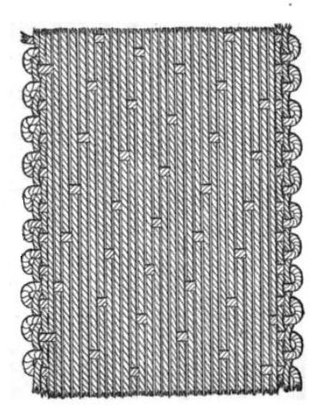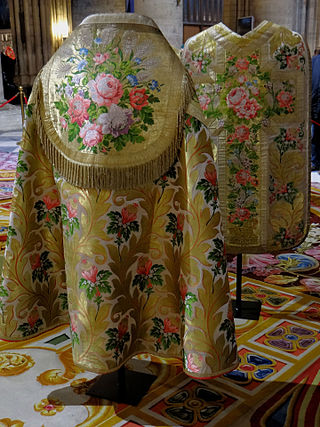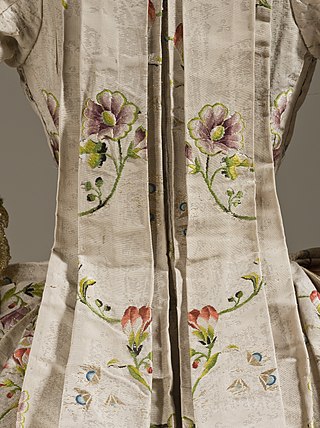
Woven fabric is any textile formed by weaving. Woven fabrics are often created on a loom, and made of many threads woven on a warp and a weft. Technically, a woven fabric is any fabric made by interlacing two or more threads at right angles to one another. Woven fabrics can be made of natural fibers, synthetic fibers, or a mixture of both, such as cotton and polyester.

A satin weave is a type of fabric weave that produces a characteristically glossy, smooth or lustrous material, typically with a glossy top surface and a dull back; it is not durable, as it tends to snag. It is one of three fundamental types of textile weaves alongside plain weave and twill weave.
Lawn cloth or lawn is a fine plain weave textile, made with fine combed cotton. Terms also used include batiste and nainsook. Originally the name applied to plain weave linen, and linen lawn is also called "handkerchief linen". The term lawn is also used in the textile industry to refer to a type of starched crisp finish given to a cloth product. The finish can be applied to a variety of fine fabrics, prints or plain.

Crêpe, also spelled crepe or crape, is a silk, wool, or synthetic fiber fabric with a distinctively crisp and crimped appearance. The term "crape" typically refers to a form of the fabric associated specifically with mourning. Crêpe was also historically called "crespe" or "crisp".

Sateen is a fabric made using a satin weave structure but with spun yarn instead of filament yarn. It is a cotton or other non-silk fabric that has the characteristics of silk satin but is less expensive.
Sendal, cendal or sandal is a thin and light silk material, chiefly used to make ceremonial clothing, church vestments, and banners. The word derives from Greek σινδων (sindōn), "fine linen"; the old French word is cendal. The word often describes a fabric woven of a linen warp and a silk weft.

Broadcloth is a dense, plain woven cloth, historically made of wool. The defining characteristic of broadcloth is not its finished width but the fact that it was woven much wider and then heavily milled in order to shrink it to the required width. The effect of the milling process is to draw the yarns much closer together than could be achieved in the loom and allow the individual fibres of the wool to bind together in a felting process, which results in a dense, blind face cloth with a stiff drape which is highly weather-resistant, hard wearing and capable of taking a cut edge without the need for being hemmed.
The manufacture of textiles is one of the oldest of human technologies. To make textiles, the first requirement is a source of fiber from which a yarn can be made, primarily by spinning. The yarn is processed by knitting or weaving, which turns it into cloth. The machine used for weaving is the loom. For decoration, the process of colouring yarn or the finished material is dyeing. For more information of the various steps, see textile manufacturing.

Brocade is a class of richly decorative shuttle-woven fabrics, often made in coloured silks and sometimes with gold and silver threads. The name, related to the same root as the word "broccoli", comes from Italian broccato meaning "embossed cloth", originally past participle of the verb broccare "to stud, set with nails", from brocco, "small nail", from Latin broccus, "projecting, pointed".

Waffle fabric, also known as honeycomb fabric, has raised threads that form small rectangles. It can be made by either weaving or knitting. Waffle weave is a further exploitation of plain weave and twill weave which produces a three-dimensional effect. The combination of warp and weft floats creates the structure. It is woven partly on tabby areas surrounded by ridges of long floats. The weave consists of warp and weft floats arranged around a plain weave center. The warp and weft threads are interlaced and floating in a way that creates small square ridges and hollows in the fabric in a regular pattern.
Gazar is a silk or wool plain weave fabric made with high-twist double yarns woven as one. Gazar has a crisp hand and a smooth texture.
Eolienne is a lightweight fabric with a ribbed (corded) surface. Generally made by combining silk and cotton or silk and worsted warp and weft, it is similar to poplin but of an even lighter weight.

Crash is a coarse fabric with a rough, irregular surface, made from thick, uneven yarns. Crash fabric is coarse linen-based rugged material made from both dyed and raw yarns. The yarns used are often grey or white in color. Crash fabrics are indistinct woven. Linen is generally used for the warp, while blends of linen and jute, cotton, and wool, etc. were used for the filling. The weave structure may vary from plain, twill to fancy. Crash fabric was very thick, strong, rough and because of linen's characteristics it is absorbent also.
Bourette is a silk fabric with bumps often blended with other yarns made of Bourette fibers. The name "Bourette" is from its constituting fiber. It has a rough surface incorporating multicolored threads and knots of spun silk. The fabric is made with silk bourette and wool or cotton yarn. Bourette is a lightweight single cloth with a rough, knotty, and uneven surface.

Sussi or susi is a term for multicolored striped or checked cloth produced mainly in Sindh. Sussi is thin handloom fabric made of cotton, silk, or a blend of the two, with colored warp stripes. Sindh region was known for its production and exports during the Mughal period. Sussi was most often made with red and blue, blue and white, or green and white stripes, but other patterns were also produced. The fabric was exported to England, where sousaes were in great demand in the 18th century.

Brocatelle is a silk-rich fabric with heavy brocade designs. The material is characterized by satin effects standing out in relief in the warp against a flat ground. It is produced with jacquard weave by using silk, rayon, cotton, or many synthetic yarns.
Barege (Barège) was a lightweight, sheer fabric matching a gauze. It was a union fabric made of silk and wool. Barege was a 19th-century fabric and originated from southwestern France. It takes its name from the town of Barèges but was mostly made in the town of Bagnères-de-Bigorre.

Faille is a type of cloth with flat ribs, often made in silk. It has a softer texture than grosgrain, with heavier and wider cords or ribs. Weft yarns are heavier than warp, and it is manufactured in plain weaving. It was especially popular in the 19th century.
Limbric was a kind of cotton cloth with a fine warp and a soft, lustrous weft. Limbric has a peculiar construction with more pick density than the ends per inch. The fabric was used for dresses and casement curtains. Made in Limbrick, Lancashire, England originally. Standard dimensions of 72x100 were used, with a warp of 64s and a weft of 30s. The superior quality of cloth was produced by using combed yarns.

The swivel weave is a weaving technique that incorporates a decorative element into the fabric by using small shuttles that insert additional weft thread around selected warp threads, while the main weft thread forms the fabric's structure. This method differs from the plain weave, which lacks this decorative aspect.













